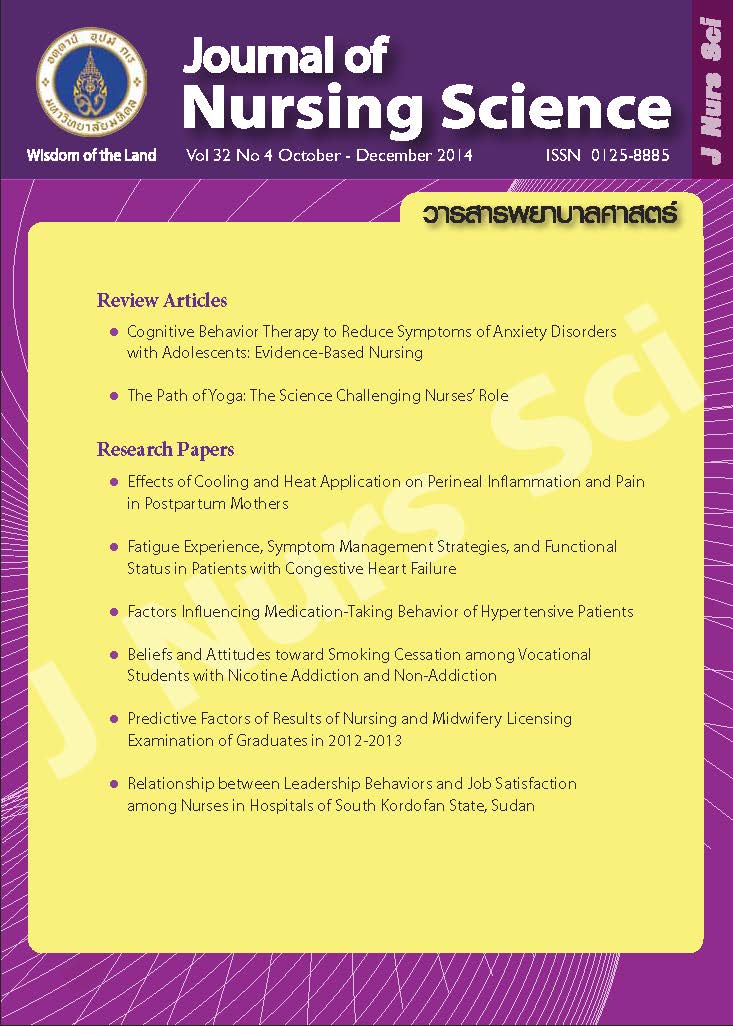Cognitive Behavior Therapy to Reduce Symptoms of Anxiety Disorders with Adolescents: Evidence-Based Nursing
Main Article Content
Abstract
Purpose: To synthesize the evidence related to cognitive behavior therapy to reduce symptoms of anxiety disorders among adolescents.
Design: A systematic review of the literature relevant to the area of interest was performed. The research evidence was searched from electronic databases and the quality and the strength of the evidence were evaluated. Eight studies met the inclusion criteria: two were systematic reviews and six were randomized controlled trials. After analysis, synthesis, and summary of the evidence, the recommendations were proposed.
Main findings: The appropriate form of cognitive behavior therapy (CBT) to reduce symptoms of anxiety disorder for children and adolescents is either individual CBT or group CBT. The clients are adolescents aged between 10 and 17 years old who are diagnosed with anxiety disorders with mild to moderate level. The total number of therapy sessions is at least eight sessions, 60 to 90 minutes per session for individual therapy and 60 to120 minutes per session for group therapy. The main components of the therapy consist of 1) provision of psychoeducation about anxiety, 2) provision of knowledge about CBT, 3) affect recognition, 4) relaxation training, 5) cognitive restructuring, 6) gradual exposures to anxiety provoking stimuli, 7) self-rewarding or reinforcement systems, 8) problem-solving skills training, and 9) relapse prevention.
Conclusion and recommendations: The CBT can reduce the number of adolescents diagnosed with anxiety disorders and can also reduce symptoms of anxiety disorders. Before applying the recommendation to practice, clinical practice guideline should be developed and a pilot study to determine the effects of the CBT should be conducted.
Keywords: adolescents, anxiety disorders, cognitive behavioral therapy, evidence-based nursing
การบำบัดการรู้คิดและปรับพฤติกรรมเพื่อลดอาการของโรควิตกกังวลในวัยรุ่น: การพยาบาลตามหลักฐานเชิงประจักษ์
บทคัดย่อ
วัตถุประสงค์: เพื่อศึกษารูปแบบการบำบัดการรู้คิดและปรับพฤติกรรม เพื่อลดอาการของโรควิตกกังวลในวัยรุ่นจากหลักฐานเชิงประจักษ์
รูปแบบการศึกษา: เป็นการทบทวนวรรณกรรมอย่างเป็นระบบ โดยการสืบค้นหลักฐานเชิงประจักษ์ที่ตรงกับประเด็นปัญหาที่ศึกษา จากฐานข้อมูลอิเล็กทรอนิกส์ ได้งานวิจัยที่ตรงตามเกณฑ์การประเมินคุณภาพและระดับความเข้มแข็งของหลักฐาน จำนวน 8 เรื่อง เป็นงาน systematic review 2 เรื่อง และ randomized controlled trial 6 เรื่อง จากนั้นนำมาวิเคราะห์ สังเคราะห์ และสรุปเป็นข้อแนะนำ
ผลการศึกษา: รูปแบบการบำบัดการรู้คิดและปรับพฤติกรรมเพื่อลดอาการของโรควิตกกังวลในวัยรุ่นที่เหมาะสมคือ การบำบัดการรู้คิดและปรับพฤติกรรมที่ให้การบำบัดกับเด็กและวัยรุ่นโดยตรง ทั้งแบบรายบุคคลและรายกลุ่ม โดยผู้เข้ารับการบำบัด มีอายุตั้งแต่ 10-17 ปี ได้รับการวินิจฉัยว่าเป็นโรควิตกกังวลในระดับเล็กน้อยถึงปานกลาง ใช้จำนวนครั้งการบำบัด 8 ครั้งขึ้นไป ครั้งละ 60-90 นาที สำหรับแบบรายบุคคล และ 60-120 นาที สำหรับแบบรายกลุ่ม องค์ประกอบหลักของการบำบัด คือ 1) การให้สุขภาพจิตศึกษาเกี่ยวกับโรควิตกกังวล 2) การให้ความรู้เกี่ยวกับการบำบัดการรู้คิดและปรับพฤติกรรม 3) การรับรู้อารมณ์ 4) การฝึกการผ่อนคลาย 5) การปรับเปลี่ยนโครงสร้างความคิดใหม่ 6) การเผชิญกับสิ่งที่ทำให้เกิดความกังวลทีละน้อยอย่างเป็นขั้นตอน 7) การให้แรงเสริมและการให้รางวัลตนเอง 8) การฝึกทักษะการแก้ปัญหา และ 9) การป้องกันการ กลับเป็นซ้ำ
สรุปและข้อเสนอแนะ: การบำบัดการู้คิดและปรับพฤติกรรมสามารถลดจำนวนเด็กและวัยรุ่นที่ได้รับการวินิจฉัยโรควิตกกังวล และลดอาการของโรควิตกกังวัลได้ ทั้งนี้ก่อนนำรูปแบบการบำบัดไปปฏิบัติจริงในหน่วยงาน ควรมีการพัฒนาเป็นแนวปฏิบัติและมีการศึกษานำร่องก่อน
คำสำคัญ: วัยรุ่น โรควิตกกังวล การบำบัดการรู้คิดและปรับพฤติกรรม การพยาบาลตามหลักฐานเชิงประจักษ์
Article Details
Copyright Notice: Nursing Science Journal of Thailand has exclusive rights to publish and distribute the manuscript and all contents therein. Without the journal’s permission, the dissemination of the manuscript in another journal or online, and the reproduction of the manuscript for non-educational purpose are prohibited.

Disclaimer: The opinion expressed and figures provided in this journal, NSJT, are the sole responsibility of the authors. The editorial board bears no responsibility in this regard.

